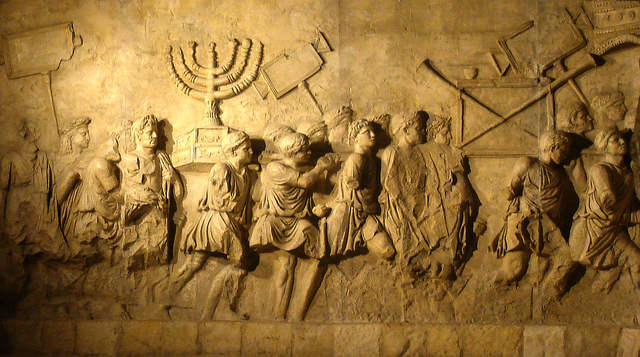*Image Credit: Wikipedia Emperor Titus, with four legions surrounding the city of Jerusalem, finally made a breakthrough in his siege on September 8, 70 — and the Holy City would never be the same. As thousands of Roman soldiers poured in to massacre the Jewish defenders, six months’ worth of frustration came to a head. Moving from place to place, the Romans destroyed everything within reach, including the Second Temple. Jerusalem would never completely be in Jewish hands ever again. The previous March, Titus brought his armies to the edges of Jerusalem intent to retake the city from the Zealots who had gained control during the Jewish Revolt of 66 CE. Holding tightly to the belief they fought for the cause of God, the Jewish fanatics managed to push back the early advances of the better-equipped, better-trained Roman force seemingly through sheer desire to avoid seeing Gentile feet walking the streets. The strong emotional ties, though a powerful motivator, would not be enough to keep the enemy out in the long term, however. In positioning his soldiers along the western and eastern sides of Jerusalem, Titus had given his army to act as a sort of gatekeeper for the city. When followers arrived from all over the countryside to celebrate the Passover, they found Roman soldiers more than willing to allow them through for the important religious occasion. When the event ended, though, Titus had ordered his legions to prevent anyone from leaving in a bid to make food and water more scarce. Incensed, the defenders launched a quick attack into the Roman ranks, killing several and wounding others. Hoping for a peaceful solution in the face of such animosity, Titus sent the Jewish historian Josephus into Jerusalem to determine the terms for a surrender. Unwilling to negotiate, the Zealots injured their countryman, sending him back out to the Romans and firing forward with another foray into the opposing line — and nearly seizing Titus. Undeterred, the Roman Emperor laid out a methodical plan to work toward the center of the city. Ten weeks after arriving, his soldiers had punched through the Second and Third Walls erected around Jerusalem. Before long, the Romans and Zealots were engaged in combat on the streets, with the Jews attempting to push their enemy back as Titus aimed to take the Fortress of Anatolia. Disorganized and undisciplined, the Zealots retreated to the Temple in order to protect themselves from devastating casualties. The only hope for the defenders now was that the Romans would grow weary and give up. To this end, some Jews spent their days continually harassing Roman soldiers attempting to attack the fortress while others were sneaking outside the city to gather water and food. With both sides aware of the strategic value of attacking the Temple from the Fortress of Anatolia, fighting was fierce. Unable to climb the walls and take control of the structure, the Romans crept in under cover of night to catch the sleeping Zealots by surprise. With the high ground now in Roman hands, the larger professional army would crush the remaining rebellion in short order. Titus, hoping to rededicate the Temple to himself and the Roman gods, sought to capture the landmark with as little destruction as possible. In the course of attacking it, however, one of the walls managed to catch fire. By early August, the Temple and surrounding homes had been consumed by the flames. The Romans, at this point solely in search of rebels to punish for the trouble they had faced, began hunting down those who had fled the Temple. On September 8, 70, with Jerusalem completely under control, soldiers gathered valuables as trophies of victory.
September 8, 70 CE – Titus Leads the Roman Sack of Jerusalem
*Image Credit: Wikipedia Emperor Titus, with four legions surrounding the city of Jerusalem, finally made a breakthrough in his siege on September 8, 70 — and the Holy City would…
836
